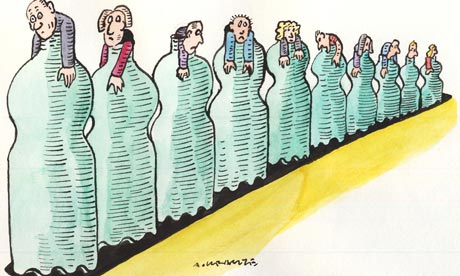Air India, India’s national carrier-turned-cadaver, is waiting for its last rites. When last heard of, the airline had turned in a loss of Rs 7,000 crore in 2010-11, and was investing in an oversized hat to hit the government for yet another bailout masquerading as a turnaround package.
Only, the amounts this time are too staggering for Pranab Mukherjee to agree to without a fight. According to a report in The Times of India, the airline will need equity support of Rs 43,255 crore just to stay afloat over the next 10 years. Mukherjee is hoping to raise that kind of money by selling public sector equity this year. If he agrees to bail out Air India, it’s as good as kissing goodbye to this moolah.
With liabilities of over Rs 47,000 crore, the airline is on the verge of defaulting on its loans. Mukherjee will thus have to chip in with some money willy-nilly – even if he is not asked for the full sum that SBI Caps has suggested as part of its revival plan for the airline. The newspaper says Air India will require Rs 8,372 crore this year itself – Rs 6,600 crore to pay its bills for 2011-12 and Rs 1,772 crore to keep up with loan payments.
But for all this, the airline still won’t be able to make a profit till 2017-18. Air India, it seems, has been fixed – and fixed for good – by former Civil Aviation Minister Praful Patel, who has often been accused by the unions of batting for Air India’s rivals till the ministry was prised away from his grip last January.
When Patel took over as Minister of State for Civil Aviation in 2004, the domestic carrier (then Indian Airlines) was market leader with a 42% share, but slipping. Today, it is No 5 – behind Jet, Kingfisher, IndiGo and SpiceJet – fighting extinction.
Here’s how Praful Patel did it – ruin Air India that is – and there’s nothing his successor Vayalar Ravi can do to rescue it.
First, load it with debt so high that it can never raise its head again. It is now clear the Air India’s financial problems began in 2004 when Praful Patel chaired a meeting of the board in which the airline suddenly inflated its order for new aircraft from 28 to 68 without a revenue plan or even a route-map for deploying the aircraft, says an India Today report.
An airline with revenues of Rs 7,000 crore was being asked to take on a debt of Rs 50,000 crore. Today, it’s losses themselves are Rs 7,000 crore. And the bailout it is seeking is as big as the cost of those 68 aircraft. The government might as well have gifted those birds to Air India.
Second, Patel presented a merger of Air India with Indian Airlines as the panacea for all ills. It is surprising how often ministers suggest mergers when public sector companies head for ruin. When telecom company MTNL was sliding, then Communications Minister Dayanidhi Maran was suggesting a merger with Bharat Sanchar Nigam Ltd. That didn’t happen, but both MTNL and BSNL are in the sick bay anyway. Praful Patel used the losses of Air India and Indian Airlines to push for their merger, claiming there would be cost savings from synergies. Worldwide, mergers usually destroy value. The Air India-IA merger has been the biggest man-made disaster in aviation history – thanks to their varying cultures and employee costs.
Says Gustav Baldauf, former COO of Air India who fell foul of Patel’s successor and had to quit: “The management never resolved the pending human resource (HR) issues related to the merger. I had warned the Chairman-cum-Managing Director and the Aviation Ministry of the consequences of introducing a single code without resolving issues first. But they never listened,” he told Mid-Day.
Third, Patel seemed to be batting for Air India’s rivals. He handed over lucrative routes to private players. Though Air India had no birthright to every lucrative route, Patel’s overnight manoeuvres in this regard suggested that he had a clear conflict of interest by being both Aviation Minister and board member in Air India.
A Tehelka report quotes Capt Mohan Ranganathan, an aviation expert, as saying that the airline handed over “flying rights on lucrative sectors in the Gulf to foreign airlines, including Etihad Airways, Qatar Airways, Air Asia, Singapore Airlines and several others…” One glaring instance of a sudden handover could not have come without Patel’s nod. Tehelka says that in October 2009, the airline sent “letters…to its stations in Kozhikode, Doha and Bahrain stating that it was withdrawing operations on the route” – a route in which the airline was making money hand over fist. Very soon, Jet and Etihad stepped in to fill the gaps, and so did Emirates.
Fourth, Praful Patel’s own airline preferences made it clear who he favoured. According to replies received under the Right to Information Act by one Jagjit Singh, Patel used mostly private airlines. Between June 1, 2009 and July 2, 2010, 26 of the 41 flights he took between Delhi and Mumbai were with Kingfisher. “It is intriguing that the minister who stresses the need for revival of the national carrier himself chooses to ignore it,” said Singh. And this happened just when the Finance Ministry was asking all government employees to use Air India for their official travel to help revive the carrier.
Patel’s haughty reply when asked about this preference of private airlines: “I am the Union Civil Aviation Minister and not the minister in charge for Air India. As a minister, it is not binding upon me to fly only one particular airline. I fly according to my convenience.” But when he ordered so many places for Air India, was he acting as Minister or superboss of the airline?
Fifth, Patel used his clout with Air India often for personal ends. Another RTI query showed that Patel’s kin used the Air India Managing Director’s office to regularly upgrade from economy to business class. Business class is a cost Patel’s family, which is rolling in wealth, can easily afford. So what does this say about Patel’s attitude to the airline?
But is the new Civil Aviation Minister going to reverse the rot set off by Patel?
According to a Financial Express report, the new turnaround plan does not look any more viable than the deadweight Patel cast on Air India by getting it to buy planes it could not afford. The newspaper quotes a Deloitte review of the SBI Caps revival plan which says it’s simply not viable.
Reason: Air India again wants to buy too many aircraft, just like Patel did. “Aviation consultancy Simat Helliesen & Eichner, which carried out a detailed route planning and capacity exercise, has suggested 87 narrow-body aircraft for Air India by 2015, but the carrier has proposed 143, according to Deloitte’s report dated February 11, 2011,” says the newspaper.
Deloitte’s comment: “The only justification that one can have for going in for such capacity expansion can, therefore, be the adoption of a strategy of buying market share through deploying high capacity into the market (with corresponding lower yields and consequent financial implications).”
This means Air India is planning to sink further into losses for years to come.
Over to you, Mr Ravi. Do you want to go down the same path Praful Patel pushed Air India?
The government’s best bet now is to cut its losses. Air India should be privatised or closed down.

